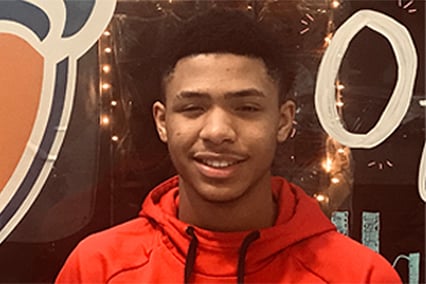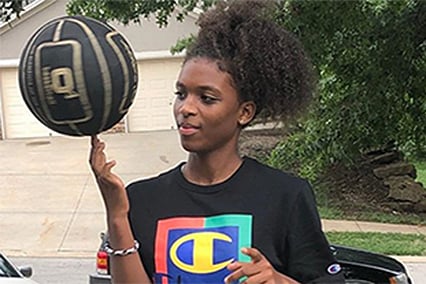Broken Tibial Eminence: Sophie’s Story
Meet Sophie
An exercise science major at the University of Kansas, Sophie Lawrence also is a member of the school’s highly athletic dance team, Rock Chalk Dance. The popular group performs at football, basketball and other KU sporting events.
But an accident while on a ski trip in Colorado over semester break benched the college student recently, resulting in surgery and months of physical therapy.
“It was Jan. 1, and a friend and I were skiing down a green trail at Beaver Creek when suddenly, I saw a group of people on the path,” Sophie said.
Sophie admits she’s an inexperienced skier, and not one to take risks, so she wasn’t sure what her next move should be.
“I needed to veer left to avoid them, but when I did, my left ski caught an edge. The right side of my body went one way, and my left the other. When I fell, I heard and felt a ‘pop.’ I knew immediately that I had done something to my left leg,” she said.
Unable to move her leg or stand, ski patrol helped Sophie to the base of the mountain. Then she was taken to a nearby emergency room where a doctor delivered the bad news.
“The doctor said I had broken my tibial eminence, that I wasn’t going to be able to do much for the next three to six months, and that I probably needed surgery right away if I ever wanted to dance again.”
The tibial eminence is also known as the tibial spine. It’s the tibial attachment of the anterior cruciate ligament, or ACL. The mechanism of injury is thought to be an internal twisting rotation force of the shin bone with a flexed knee, like when Sophie was trying to turn her skis to avoid the group.
With her mind reeling from the diagnosis, Sophie said all she could think was, “You must have the wrong person. This cannot be happening.”
Unfortunately, it was. Sophie immediately contacted her family in Kansas City and her dance team coach to let them know about the injury. Wearing a brace to stabilize her left leg, she flew home on Jan. 2. The next day, she met with her Children’s Mercy pediatric orthopedic surgeon.
“After that meeting, I was completely satisfied that I was in the right place to get the help I needed to get better,” Sophie said.
After more testing, Sophie’s diagnosis was confirmed, adding that she would need two screws placed in her knee to repair the break.
On Jan. 7, a successful outpatient operation was performed that put Sophie’s left knee back together, but additional swelling in her ACL and meniscus was found during the procedure.
“Originally, it was thought I would be able to walk with crutches right away, but because of the swelling, it was recommended I stay off my left leg for six weeks,” Sophie said.
Walk first, dance later
Two weeks after surgery, Sophie started to rehabilitate her knee, first at Children’s Mercy Sports Medicine Blue Valley, then transferred to Village West to begin aquatic therapy.
“Because I couldn’t bear weight on my left leg, I started my physical therapy using hydrotherapy pool at Village West,” Sophie said.
Village West is a 13,000-square-foot gymnasium with state-of-the-art equipment, like the hydrotherapy pool and advanced Pilates equipment, both important to Sophie’s recovery.
Working with Kayla Greiner, PT, DPT, OCS, a sports medicine physical therapist at Village West, Sophie began juggling twice-weekly pool therapy sessions with classes at KU.
“I thought the pool was so cool because the platform could lower and raise. I didn’t have to jump in or climb out of the water. Plus, I could watch myself while walking because of the underwater cameras,” Sophie said. “The pool made it so much easier to regain the movement that I would need to walk on solid ground, and I think it sped up my recovery.”
Kayla agreed. “Sophie hadn’t walked or put weight through her leg for so long; it was really hard for her to bend her knee. The pool unweights the patient, which is especially important for someone like Sophie with weight-bearing restrictions. She was able to bend her knee in the water. That helped her work on her range of motion and body mechanics in a safe environment.”
Six weeks later, after making great progress, Sophie was released her from the weight-bearing restrictions.
A special challenge…
About that same time, COVID-19 began to hit the greater Kansas City area, shutting most medical services down. At Children’s Mercy Village West, therapists kept working with high-priority patients while wearing masks and carefully sanitizing their hands and equipment.
“Sophie’s goal was to be ready for Rock Chalk Dance tryouts in early April,” Kayla said. “She had just been released to bear weight on her leg.
“I knew that it was very important to continue Sophie’s therapy if she was going to be ready in time for tryouts, and I knew that based on her maturity level, she would take the stay-at-home orders seriously, would wear a mask, and would wash her hands. I was right. She did an awesome job.”
After graduating from the pool, Kayla introduced Sophie to the Pilates equipment at Village West, including the Pilates chair and the reformer. Both pieces of equipment helped Sophie strengthen her muscles and improve her overall balance and control, important skills for dance.
But Sophie continued to have problems jumping and leaping. To help develop the extra power and lift she needed to get off the ground quickly, Kayla added the VertiMax to Sophie’s rehab routine.
The VertiMax is a small platform with cords similar to bungees attached to a belt that Sophie wore around her waist. The equipment helped improve Sophie’s jumping ability by providing resistance as she jumped up, then helping her gain control of her body as it descended by pulling her back down.
As Sophie regained her strength, flexibility and balance, she also began working on her endurance, a skill necessary to perform the high-energy dance routines she would need to make Rock Chalk Dance.
“Sophie told me that her routines were about 45 seconds long, so I shaped her workouts around that time frame to help improve her cardiovascular system,” Kayla explained.
Sophie also used the gym flooring at the Village West facility to practice the old dance routines, while utilizing the mirrors to critique her movements.
“When we came to a spot in a routine that was causing her a problem, I would look at the movement closely, and tailor her treatment accordingly,” Kayla said.
Tiny dancer
As early April approached, stay-at-home orders remained in place. There were no in-person tryouts for Rock Chalk Dance. Instead, candidates took part in a three-day online tryout, a first due to the coronavirus.
“As Sophie practiced the choreography, I became really focused on getting her ready for try-outs,” Kayla said. “She was so motivated and such a hard worker, I was heavily invested in her success. I even found myself checking the dance team’s social media to see if she made it.”
And she did! Sophie’s dedication not only helped her recover from the skiing accident, but made it possible for her return to dance—her passion since she was just 3 years old.
“Dance has been an important part of my life since I was just a tiny, little girl,” Sophie said. “I love it. It’s how I show my emotions, and I love Rock Chalk Dance because I get to meet and talk with so many people who love KU as much as I do.”
As Sophie completed her rehab, she said the time had flown by, but in reality, she’d been working with Kayla for five months.
“Kayla has helped me work on my quad strength because that is something I have struggled with, but in the last few weeks I’ve seen so much progress in my strength, endurance, flexibility and balance,” Sophie added. “I’ve been practicing the KU fight song in my driveway.”
“Sophie is super coordinated and that has made it easier to teach her the exercise and movement patterns she needed to work on during her rehabilitation,” Kayla said. “Plus, she was very committed—her goal became my goal.”
Lessons learned
Now that Sophie has passed her isokinetic testing, she’s ready to actually return to Rock Chalk Dance when practice begins in mid-July. The isokinetic test is a high-tech device used to evaluate strength, endurance, power throughout a range of motion of the major joints—a gold standard in therapy.
Since the accident, Sophie said she’s gone to games and competitions, has helped with practices, and has driven her teammates to their games.
“Having dance slip out of my hands within 30 seconds of falling while skiing down a mountain has been difficult,” Sophie said. “I sometimes think, ‘What if I had just taken five minutes longer for lunch, or if I had turned sooner?’ Maybe this wouldn’t have happened. But at the same time, it’s been a great experience to look at dance from this side.
“Getting to see the team from the sidelines wasn’t necessarily what I had planned on or what I wanted, but it’s given me a new appreciation for how much I miss dance. I can’t wait to get back,” she said.
Plus, she’s learned to be patient with herself. “Sometimes, legs don’t heal as fast as you think they should. That was out of my control, but I went to every therapy session and pushed myself as hard as I could.
“When I first walked in to Village West, I had no idea what all this equipment did or how to use it, but I do now,” she said. “Every time I came to rehab, I saw kids of all ages rehabbing for their respective sports.
“It’s sometimes easy for me to get down. There have been days when I have wondered if I would ever be able to dance again, but I am. Kayla and all of the therapists have been positive and supportive. Children’s Mercy and Village West have been a great environment for me.”
“Sophie has been successful because she was very committed to her rehab, despite all the distractions with COVID-19,” Kayla said. “None of that set her back emotionally or physically. Her ability to adapt and be flexible helped her prepare for tryouts and make the team.”
“Kayla was like my coach,” Sophie said. “She knew when to push me and how to motivate me so I didn’t quit or give up. She’s a great physical therapist. I am going to miss seeing her every week.”
Broken kneecap and tibia: Antonio’s story
A broken kneecap and tibia literally disabled Antonio Briscoe, making every movement a struggle. But thanks to Antonio’s determination and months and months of therapy with Children’s Mercy Sports Medicine, he’s back on the basketball court.

Torn left ACL: Saneea’s story
A talented 16-year-old point guard for the Blue Springs South Jaguars, Saneea Bevley tore her left ACL playing in an AAU game in April 2019. After surgery and months of rehabilitation with the Children’s Mercy Sports Medicine Center, she finished her high school season strong, determined to play better than ever.

- Sports Medicine Center
- Adaptive Sports Medicine Program
- Athletic Training Services
- Concussion Treatment
- Full Athlete Care
- Injury Management
- Orthopedics
- Partnerships
- Pediatric Sports Medicine Fellowship
- Sports Medicine Conference
- Sports Medicine Surgery
- Sports Physical Therapy
- 360° Tour of Village West
- Meet the Sports Medicine Center Team